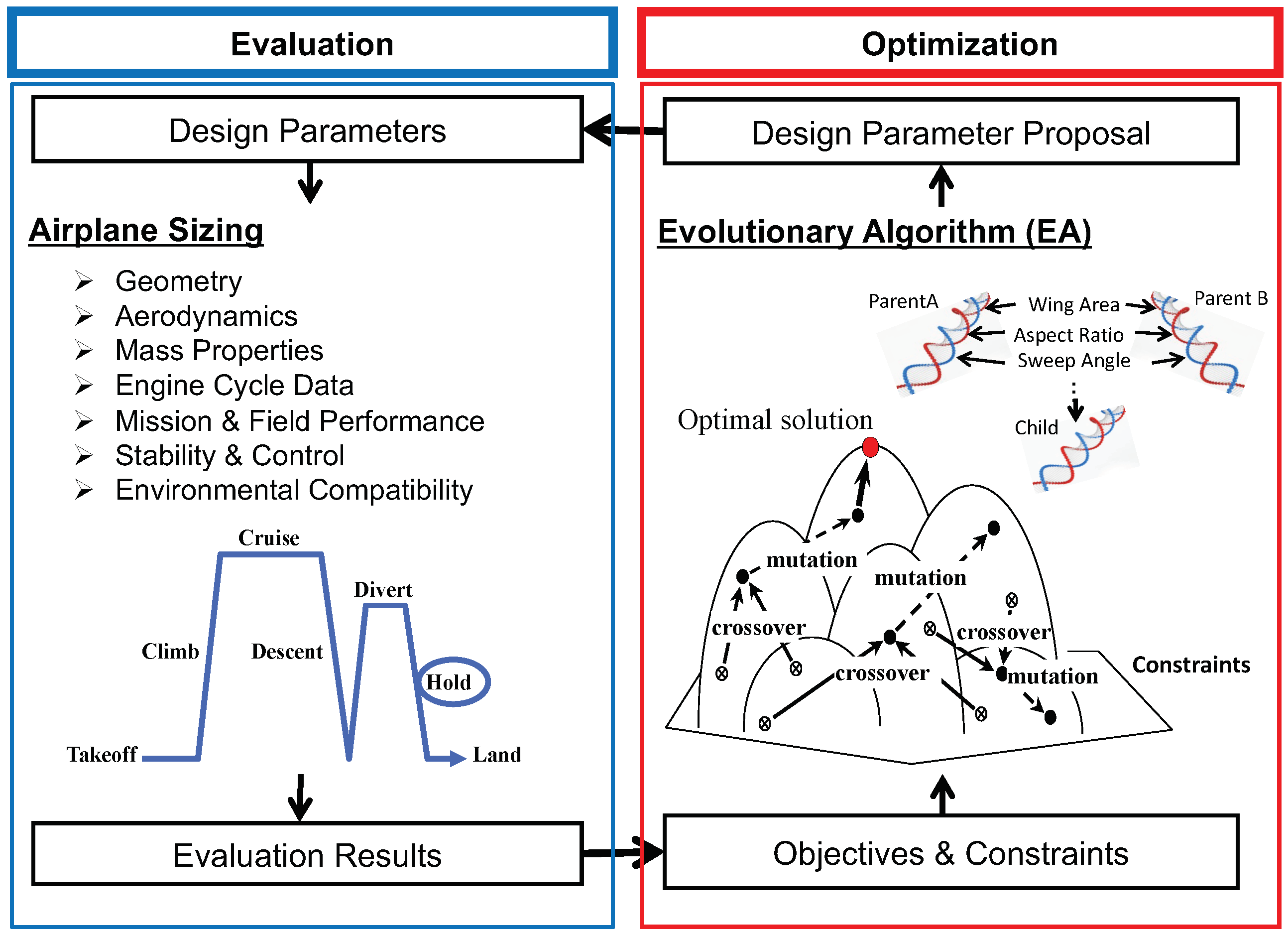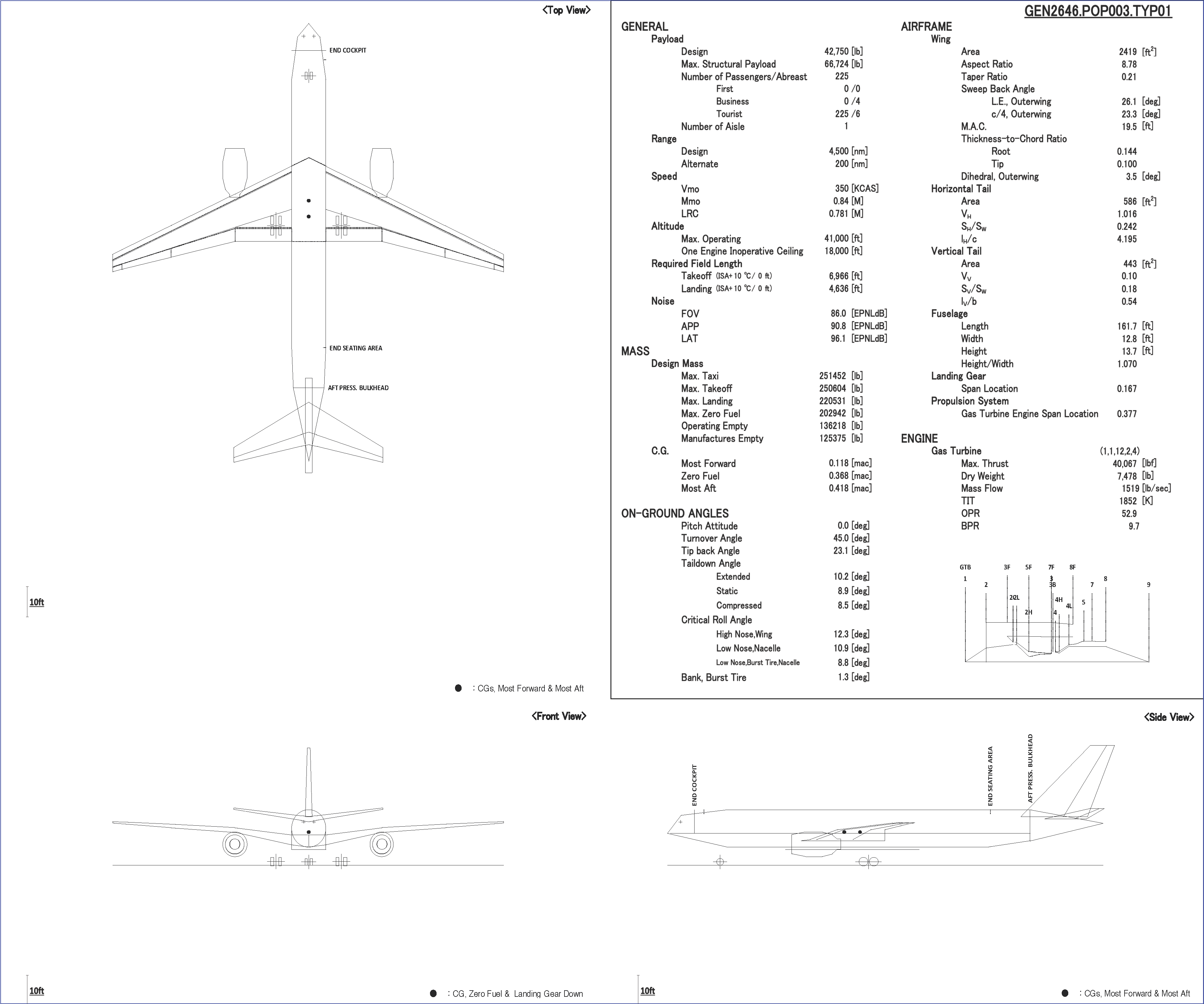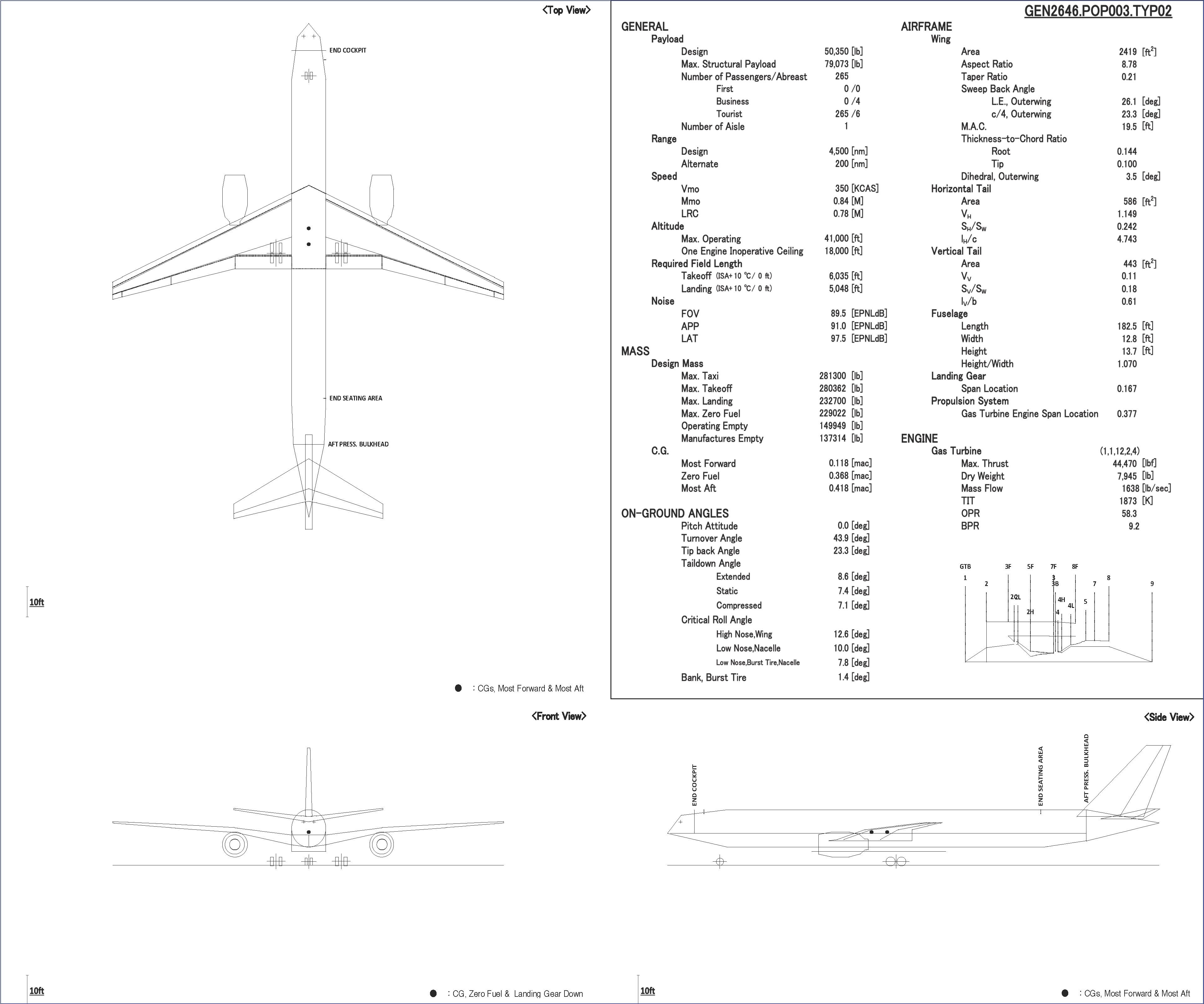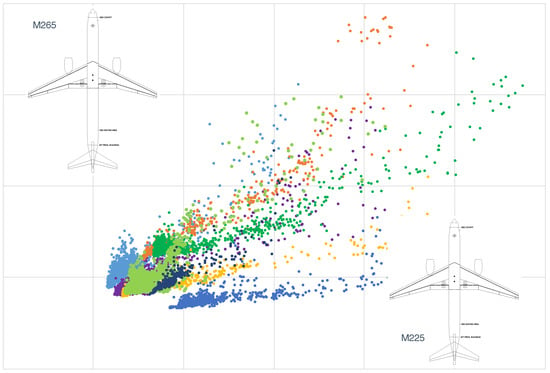A Formulation of the Industrial Conceptual Design Optimization Problem for Commercial Transport Airplanes
Abstract
:1. Introduction
2. Formulation
2.1. Design Parameters
2.1.1. Wing
2.1.2. Fuselage
2.1.3. Tail
2.1.4. Engine
2.1.5. Main Landing Gear
2.1.6. Center of Gravity
2.1.7. Summary of Design Parameter Selection
2.2. Constraints
2.2.1. Wing
2.2.2. Engine
2.2.3. Landing Gear
2.2.4. Mission Performance
2.2.5. Field Performance
2.2.6. Stability and Control
2.2.7. Environmental Compatibility
2.2.8. Summary of Constraint Selection
2.3. Objectives
3. Sample Problem
3.1. Performance Specifications
3.2. Optimization Method
3.2.1. Proposing Design Parameters
3.2.2. Evaluating Design Parameters
3.3. Optimization Setup
3.4. Results and Discussion
4. Conclusions
Author Contributions
Funding
Institutional Review Board Statement
Informed Consent Statement
Data Availability Statement
Acknowledgments
Conflicts of Interest
Abbreviations
| BPR | Bypass ratio |
| CAP | Control anticipation parameter |
| CFD | Computational fluid dynamics |
| CG | Center of gravity |
| CHT | Constraint-handling technique |
| CMOGA | Constrained multiobjective genetic algorithm |
| EA | Evolutionary algorithm |
| EPNL | Effective perceived noise level |
| FAR | Federal Aviation Regulations |
| FEA | Finite Element Analysis |
| FOD | Foreign object damage |
| MLVM | More less-violations method |
| MOGA | Multiobjective genetic algorithm |
| OPR | Overall pressure ratio |
| TCAD | Transport-category airplane design program |
| TIT | Turbine inlet temperature |
| VLM | Vortex lattice method |
| V | Takeoff decision speed |
| V | Takeoff safety speed |
| V | Engine failure speed |
| V | Final takeoff speed |
| V | Liftoff speed |
| V | Minimum control speed, in the air |
| V | Minimum control speed, in the landing configuration |
| V | Minimum control speed, on the ground |
| V | Minimum unstick speed |
| V | Rotation speed |
| V | Landing reference speed |
| V | Stall speed, reference |
| Time to achieve 30 degrees bank angle change | |
| Undamped natural frequency, Dutch roll | |
| Undamped natural frequency, short-period response | |
| Damping ratio, Dutch roll | |
| Damping ratio, short-period response |
References
- Roskam, J. Airplane Design, 1st ed.; DARcorporation: Lawrence, KS, USA, 1985; Volumes 1–8. [Google Scholar]
- Raymer, D. Aircraft Design: A Conceptual Approach, 1st ed.; AIAA Education Series (AIAA): Washington, DC, USA, 1989; Available online: https://perma.cc/U478-X52U (accessed on 22 August 2022).
- Jenkinson, L.; Simpkin, P.; Rhodes, D. Civil Jet Aircraft Design, 1st ed.; AIAA Education Series; AIAA: Washington, DC, USA, 1999. [Google Scholar]
- Torenbeek, E. Advanced Aircraft Design: Conceptual Design, Analysis and Optimization of Subsonic Civil Airplanes; Aerospace Series; John Wiley & Sons: Hoboken, NJ, USA, 2013. [Google Scholar]
- U.S. Government Publishing Office. Title 14 Code of Federal Regulations. 2021. Available online: https://www.ecfr.gov/current/\title-14 (accessed on 22 August 2022).
- ICAO Annex 16 to the Convention on International Civil Aviation. In Environmental Protection—Volume I—Aircraft Noise, 8th ed.; July 2017; Available online: https://digitallibrary.un.org/record/421894 (accessed on 22 August 2022).
- Sobieski, J.; Haftka, R. Multidisciplinary aerospace design optimization: Survey of recent developments. In Proceedings of the 34th Aerospace Science Meeting and Exhibit (AIAA 96-0711), Reno, NV, USA, 15–18 January 1995. [Google Scholar] [CrossRef]
- Kroo, I. An interactive system for aircraft design and optimization. In Proceedings of the Aerospace Design Conference (AIAA 92–1190), Irvine, CA, USA, 3–6 February 1992. [Google Scholar] [CrossRef]
- Crispin, Y. Aircraft conceptual optimization using simulated evolution. In Proceedings of the 32nd Aerospace Sciences Meeting and Exhibit (AIAA 94–0092), Reno, NV, USA, 10–13 January 1994. [Google Scholar] [CrossRef]
- Gage, P. New Approaches to Optimization in Aerospace Conceptual Design; Technical Report NASA CR–196695; NASA: Washington, DC, USA, 1995. Available online: https://ntrs.nasa.gov/citations/19950018016 (accessed on 22 August 2022).
- Roth, G.; Crossley, W. Commercial transport aircraft conceptual design using a genetic algorithm based approach. In Proceedings of the 7th AIAA/USAF/NASA/ISSMO Symposium on Multidisciplinary Analysis and Optimization (AIAA 98–4934), St. Louis, MO, USA, 2–4 September 1998. [Google Scholar] [CrossRef]
- Perez, R.; Chung, J.; Behdinan, K. Aircraft conceptual design using genetic algorithms. In Proceedings of the 8th Symposium on Multidisciplinary Analysis and Optimization (AIAA–2000–4938), Long Beach, CA, USA, 6–8 September 2000. [Google Scholar] [CrossRef]
- Perez, R.; Behdinan, K. Effective multi-mission aircraft conceptual design optimization using a hybrid multi-objective evolutionary method. In Proceedings of the 9th AIAA/ISSMO Symposium on Multidisciplinary Analysis and Optimization (AIAA–2002–5464), Atlanta, GA, USA, 4–6 September 2002. [Google Scholar] [CrossRef]
- Cai, Y.; Rajaram, D.; Mavris, D.N. Simultaneous aircraft sizing and multi-objective optimization considering off-design mission performance during early design. Aerosp. Sci. Technol. 2022, 126, 107662. [Google Scholar] [CrossRef]
- Antonie, N.; Kroo, I. Framework for Aircraft Conceptual Design and Environmental Performance Studies. AIAA J. 2005, 43, 2100–2109. [Google Scholar] [CrossRef]
- Schwartz, E.; Kroo, I. Aircraft design: Trading cost and climate impact. In Proceedings of the 47th AIAA Aerospace Sciences Meeting Including The New Horizons Forum and Aerospace Exposition (AIAA 2009–1261), Orlando, FL, USA, 5–8 January 2009. [Google Scholar] [CrossRef]
- Henderson, R.; Martins, J.; Perez, R. Aircraft Conceptual Design for Optimal Environmental Performance. Aeronaut. J. 2012, 116, 1–22. [Google Scholar] [CrossRef] [Green Version]
- Karpuk, S.; Radespiel, R.; Elham, A. Assessment of Future Airframe and Propulsion Technologies on Sustainability of Next-Generation Mid-Range Aircraft. Aerospace 2022, 9, 279. [Google Scholar] [CrossRef]
- Saravanamuttoo, H.; Rogers, G.; Cohen, H.; Straznicky, P. Gas Turbine Theory, 6th ed.; Pearson Education Ltd.: London, UK, 2009. [Google Scholar]
- Royal Aeronautical Society. An Introduction to Aircraft Noise; ESDU 02020 Amendment B; Royal Aeronautical Society: London, UK, 2013. [Google Scholar]
- Currey, N. Aircraft Landing Gear Design: Principles and Practices, 1st ed.; AIAA Education Series; AIAA: Washington, DC, USA, 1988. [Google Scholar]
- Chai, S.; Mason, W. Landing Gear Integration in Aircraft Conceptual Design; Technical Report MAD 96-09-01; Virginia Polytechnic Institute and State University: Blacksburg, VA, USA, 1996. Available online: https://ntrs.nasa.gov/citations/19970031272 (accessed on 22 August 2022).
- Boeing. Airplane Characteristics for Airport Planning. Available online: https://www.boeing.com/commercial/airports/plan_manuals.page (accessed on 22 August 2022).
- Airbus. Aircraft Characteristics: Airport Operations & Tech Data—Airport and Maintenance Planning. Available online: https://www.airbus.com/en/airport-operations-and-technical-data/aircraft-characteristics (accessed on 22 August 2022).
- Nita, M.F. Contributions to Aircraft Preliminary Design and Optimization. Ph.D. Thesis, Politehnica University of Bucharest, Bucharest, Romania, 2012. Available online: https://perma.cc/SM5U-EPT9 (accessed on 22 August 2022).
- Scholz, D. Aircraft Design. Lecture Notes. 2015. Available online: http://HOOU.ProfScholz.de (accessed on 22 August 2022).
- US Department of Defence. Flying Qualities of Piloted Airplanes; MIL–F–8785C. 5 November 1980. Available online: https://perma.cc/FN56-6YAG (accessed on 22 August 2022).
- ICAO Annex 16 to the Convention on International Civil Aviation. In Environmental Protection—Volume III—Airplane CO2 Emissions, 1st ed.; July 2017; Available online: https://perma.cc/SQ74-DSP3 (accessed on 22 August 2022).
- Ritchie, H.; Roser, M.; Rosado, P. CO2 and Greenhouse Gas Emissions. Our World in Data. 2020. Available online: https://perma.cc/694W-FCMD (accessed on 22 August 2022).
- Air Transport Association of America. Standard Method of Estimating Comparative Direct Operating Costs of Turbine Powered Transport Airplanes; Air Transport Association of America: Washington, DC, USA, 1967; Available online: https://docplayer.net/39861253-Standard-method-of-estimating-comparative-direct-operating-costs-of-turbine-powered-transport-airplanes.html (accessed on 22 August 2022).
- Sliwa, S.; Arbuckle, P. OPDOT: A Computer Program for the Optimum Preliminary Design of A Transport Airplane; Technical Report NASA TM–81857; NASA: Washington, DC, USA, 1980. Available online: https://ntrs.nasa.gov/citations/19830002844 (accessed on 22 August 2022).
- Kroo, I.; Takai, M. A quasi-procedural, knowledge-based system for aircraft design. In Proceedings of the AIAA/AHS/ASEE Aircraft Design, Systems and Operating Meeting (AIAA–88–4428), Atlanta, GA, USA, 7–9 September 1988. [Google Scholar] [CrossRef]
- Jayaram, S.; Myklebust, A. ACSYNT—A Standards-based system for parametric computer aided conceptual design of aircraft. In Proceedings of the Aerospace Design Conference (AIAA 92–1268), Irvine, CA, USA, 3–6 February 1992. [Google Scholar] [CrossRef]
- Hoburg, W.; Abbeel, P. Geometric Programming for Aircraft Design Optimization. AIAA J. 2014, 52, 2414–2426. [Google Scholar] [CrossRef]
- Eiben, A.; Smith, J. Introduction to Evolutionary Computing, 2nd ed.; Natural Computing Series; Springer: Berlin/Heidelberg, Germany, 2015. [Google Scholar] [CrossRef]
- Fonseca, C.; Fleming, P. Genetic algorithms for multiobjective optimization: Formulation, discussion and generalization. In Proceedings of the Fifth International Conference, San Mateo, CA, USA, 13–15 July 1993; Available online: https://perma.cc/SL3J-EF6U (accessed on 22 August 2022).
- Coello, C. Theoretical and Numerical Constraint-Handling Techniques Used with Evolutionary Algorithms: A Survey of the State of the Art. Comput. Methods Appl. Mech. Eng. 2002, 191, 1245–1287. [Google Scholar] [CrossRef]
- Mezura-Montes, E.; Coello, C. Constraint-handling in nature-inspired numerical optimization: Past, present, and future. Swarm Evol. Comput. 2011, 1, 173–194. [Google Scholar] [CrossRef]
- Takami, H.; Obayashi, S. A Comparator-based Constraint Handling Technique for Evolutionary Algorithms. AIP Adv. 2022, 12, 055229. [Google Scholar] [CrossRef]
- Takami, H. MLVM—A Constraint-Handling Technique for Evolutionary Algorithms “More Less-Violations Method (MLVM)”. Available online: https://github.com/hikarutakami/MLVM (accessed on 22 August 2022).
- Smith, H.; Sziroczák, D.; Abbe, G.E.; Okonkwo, P. The GENUS aircraft conceptual design environment. Proc. Inst. Mech. Eng. Part G J. Aerosp. Eng. 2018, 233, 2932–2947. [Google Scholar] [CrossRef]
- Miranda, L.; Elliot, R.; Baker, W. A Generalized Vortex Lattice Method for Subsonic and Supersonic Flow Applications; Technical Report NASA CR-2865; NASA: Washington, DC, USA, 1977. Available online: https://ntrs.nasa.gov/citations/19800000236 (accessed on 22 August 2022).
- Fink, R. USAF Stability and Control DATCOM; Technical Report AFWAL-TR-83-3048; Flight Dynamics Laboratory, Air Force Wright Aeronautical Laboratories: Washington, DC, USA, 1978; Available online: https://perma.cc/LQ5Y-RE5K (accessed on 22 August 2022).
- Hoerner, S. Fluid-Dynamic Drag; Hoerner Fluid Dynamics: Bakersfield, CA, USA, 1965; Available online: https://n2t.net/ark:/13960/t57f0bk2j (accessed on 22 August 2022).
- Glatt, C. WAATS—A Computer Program for Weights Analysis of Advanced Transportation Systems; Technical Report NASA CR-2420; NASA: Washington, DC, USA, 1974. Available online: https://ntrs.nasa.gov/citations/19740027176 (accessed on 22 August 2022).
- Kurzke, J. GasTurb Details 6; GasTurb GmbH: Aachen, Germany, 2021; Available online: https://perma.cc/ZBM3-GX8Q (accessed on 22 August 2022).
- Seddon, J.; Goldsmith, E. Intake Aerodynamics, 1st ed.; AIAA Education Series; AIAA: New York, NY, USA, 1985. [Google Scholar]
- Covert, E. (Ed.) Thrust and Drag: Its Prediction and Verification, 1st ed.; Progress in Astronautics and Aeronautics; AIAA: New York, NY, USA, 1985; Volume 98. [Google Scholar] [CrossRef]
- Pera, R.; Onat, E.; Klees, G.; Tjonneland, E. A Method to Estimate Weight and Dimensions of Aircraft Gas Turbine Engines Volume I: Method of Analysis Final Report; Technical Report NASA CR-135170; NASA: Washington, DC, USA, 1977. Available online: https://ntrs.nasa.gov/citations/19770018227 (accessed on 22 August 2022).
- McLean, D. Automatic Flight Control Systems; Series in Systems and Control Engineering; Prentice Hall International: London, UK, 1990. [Google Scholar]
- Scholz, D. Corrected: McLean, D. Automatic Flight Control Systems; Series in Systems and Control Engineering. 2022. Available online: https://perma.cc/VPA5-JPP2 (accessed on 22 August 2022).
- Katayanagi, R. Stability and Control of Airplanes, 1st ed.; Morikita Publishing: Tokyo, Japan, 2007. (In Japanese) [Google Scholar]
- Zorumski, W. Aircraft Noise Prediction Program Theoretical Manual; Technical Report NASA TM-83199 Part 1; NASA: Washington, DC, USA, 1982. Available online: https://ntrs.nasa.gov/citations/19820012072 (accessed on 22 August 2022).
- Zorumski, W. Aircraft Noise Prediction Program Theoretical Manual; Technical Report NASA TM-83199 Part 2; NASA: Washington, DC, USA, 1982. Available online: https://ntrs.nasa.gov/citations/19820012073 (accessed on 22 August 2022).
- Stone, J.; Krejsa, E.; Clark, B. Enhanced Core Noise Modeling for Turbofan Engines; Technical Report NASA/CR-2011-217026; NASA: Washington, DC, USA, 2011. Available online: https://ntrs.nasa.gov/citations/20110013366 (accessed on 22 August 2022).
- Stone, J.; Krejsa, E.; Clark, B. Jet Noise Modeling for Suppressed and Unsuppressed Aircraft in Simulated Flight; Technical Report NASA/TM-2009-215524; NASA: Washington, DC, USA, 2009. Available online: https://ntrs.nasa.gov/citations/20090015381 (accessed on 22 August 2022).
- Royal Aeronautical Society. Evaluation of the Attenuation of Sound by an Uniform Atmosphere; ESDU 78002 Amendment D; Royal Aeronautical Society: London, UK, 2019; ISBN 978 0 85679 208 3. [Google Scholar]
- Royal Aeronautical Society. The Correction of Measured Noise Spectra for the Effects of Ground Reflection; ESDU 94035; Royal Aeronautical Society: London, UK, 2011; ISBN 978 0 85679 922 8. [Google Scholar]
- Royal Aeronautical Society. Estimation of Lateral Attenuation of Air-to-Ground Jet or Turbofan Aircraft Noise in One-Third Octave Bands; ESDU 82027; Royal Aeronautical Society: London, UK, 2011; ISBN 978 0 85679 408 7. [Google Scholar]
- Greitzer, E.; Bonnefoy, P.; delaRosaBlanco, E.; Dorbian, C.; Drela, M.; Hall, D.; Hansman, R.; Hileman, J.; Liebeck, R.; Lovegren, J.; et al. N+3 Aircraft Concept Designs and Trade Studies; Technical Report NASA/CR—2010-216794/VOL1; NASA: Washington, DC, USA, 2010; Volume 1. Available online: https://ntrs.nasa.gov/citations/20100042401 (accessed on 22 August 2022).
- Welstead, J.R.; Felder, J.L. Conceptual design of a single-aisle turboelectric commercial transport with fuselage boundary layer ingestion. In Proceedings of the 54th AIAA Aerospace Sciences Meeting, San Diego, CA, USA, 4–8 January 2016. [Google Scholar] [CrossRef] [Green Version]




| Parameter | Group 1 | Lower Bound | Upper Bound |
|---|---|---|---|
| Wing | |||
| Area (ft) | c | 2000 | 4000 |
| Aspect ratio | c | 5.0 | 15.0 |
| Sweepback angle, leading-edge (deg) | c | 20.0 | 40.0 |
| Spanwise boundary between aileron and flaps (fraction of semispan) | c | 0.7 | 0.8 |
| Thickness-to-chord ratio, theoretical root | c | 0.1 | 0.2 |
| Dihedral angle, inboard wing (deg) | c | 0.0 | 10.0 |
| Dihedral angle increment, outboard wing (deg) | c | −10.0 | 5.0 |
| Deflection angle, trailing-edge flap at takeoff (deg) | d | 1.0 | 20.0 |
| Deflection angle, trailing-edge flap at landing (deg) | d | 25.0 | 40.0 |
| Tail | |||
| Area ratio, vertical tail to wing | c | 0.05 | 0.35 |
| Area ratio, horizontal tail to wing | c | 0.05 | 0.35 |
| Engine | |||
| Thrust (lbf) | d | 25,000 | 55,000 |
| Turbine inlet temperature (℃) | d | 1400 | 1600 |
| Overall pressure ratio | d | 20.0 | 70.0 |
| Bypass ratio | d | 5.0 | 15.0 |
| Spanwise location (fraction of wing semispan) | c | 0.2 | 0.4 |
| Main Landing gear | |||
| Spanwise location (fraction between fuselage centerline and engine station) | c | 0.0 | 1.0 |
| Chordwise location (fraction between rear spar and landing gear beam) | c | 0.0 | 1.0 |
| Center of gravity | |||
| The most aft CG, with respect to mean aerodynamic chord | c | 0.25 | 0.50 |
| Constraint 1,2 | Requirement |
|---|---|
| Wing (1) | |
| Fuel tank volume | ≥Fuel volume |
| Engine (3) | |
| Compressor discharge height | ≥0.5 (inch) |
| Angle, nose landing gear to the most inboard point of engine inlet | ≥25.0 (deg) |
| Ground clearance, the lowest point of engine inlet | ≥0.5 × engine inlet diameter |
| Landing gear (8) | |
| Distance between trunnion and main landing gear | ≥0.33 × main landing gear length |
| Local wing thickness at main landing gear installation | ≥1.5 × main landing gear strut diameter |
| Main landing gear bogie accommodation | No interference with carry-through structure |
| Tipback angle | ≥Tail down angle |
| Turnover angle | ≤45.0 (deg) |
| Roll boundary on the ground, static | ≥10.0 (deg) |
| Roll boundary on the ground, tail-down attitude | ≥12.0 (deg) |
| Static load fraction, nose landing gear | ≥0.05 |
| Cruise performance (2) | |
| Long range cruise Mach number | ≥Specified long range cruise Mach number |
| Ceiling, one engine inoperative | ≥Specified ceiling |
| Field performance (17) | |
| FAR takeoff field length | ≤Specified takeoff field length |
| FAR landing field length | ≤Specified landing field length |
| FAR climb gradients 3 | As per FAR |
| FAR speed relations 4 | As per FAR |
| Stability and Control (41) | |
| Related to FAR (15) | |
| FAR maneuvers [V, V + XX, V, V] | within 75 percent of control surface authorities 9 |
| Elevator capability [V, V] | within 75 percent of elevator authority |
| Elevator capability, nose-down angular acceleration at stall | ≥0.1 (rad/s) |
| Rudder capability [V, V, V] | Trimmable |
| Rudder capability, crosswind landing | Trimmable for specified crosswind |
| Related to MIL (26) | |
| Longitudinal short-period response 5 | MIL-F-8785C Level 1 |
| Lateral-directional oscillation (Dutch roll) 6 | MIL-F-8785C Level 1 |
| Roll performance 7 | MIL-F-8785C Level 1 |
| Environmental Compatibility (4) | |
| Airport noise 8 | As per Annex 16 Volume I Chapter 14 |
| Specification | M225 | M265 |
|---|---|---|
| Entry into service year (technology level) | 2030 | 2030 |
| Number of passengers (all economy) | 225 | 265 |
| Long range cruise Mach number | 0.78 | 0.78 |
| Design range | 4500 (nm) | 4500 (nm) |
| FAR takeoff field length | 7000 (ft) | 8000 (ft) |
| FAR landing field length | 5000 (ft) | 5500 (ft) |
| Max. crosswind for landing | 30 (kt) | 30 (kt) |
| Operational flight envelope | 41,000 (ft)/0.84 (Mach)/350 (kt) | 41,000 (ft)/0.84 (Mach)/350 (kt) |
| Ceiling with one engine inoperative | 18,000 (ft) | 18,000 (ft) |
| Item | Group 1 | Run 1 | Run 2 | Run 3 | Run 4 | Run 5 | Run 6 | Run 7 | Run 8 | B757 2 |
|---|---|---|---|---|---|---|---|---|---|---|
| General | ||||||||||
| Entry into service year (technology level) | 2030 | 2030 | 2030 | 2030 | 2030 | 2030 | 2030 | 2030 | 1983 | |
| Gross weight, takeoff (lb), M225 | 253,848 | 254,142 | 256,073 | 251,068 | 248,000 | 256,831 | 250,604 | 253,346 | 255,000 | |
| Gross weight, takeoff (lb), M265 | 278,468 | 282,924 | 284,661 | 278,696 | 277,774 | 282,758 | 280,362 | 280,941 | 270,000 | |
| Block fuel weight (lb), M225 | 69,274 | 67,808 | 68,357 | 66,653 | 65,889 | 68,155 | 66,203 | 66,867 | - | |
| Block fuel weight (lb), M265 | 73,314 | 75,998 | 76,185 | 73,951 | 74,407 | 74,061 | 74,076 | 74,076 | - | |
| Wing loading (lb/ft), M225 | 105.3 | 107.9 | 107.5 | 104.2 | 105.7 | 104.6 | 103.6 | 102.2 | 125.1 | |
| Wing loading (lb/ft), M265 | 115.5 | 120.1 | 119.6 | 115.7 | 118.4 | 115.2 | 115.9 | 113.4 | 132.5 | |
| Thrust-to-weight ratio, M225 | 0.309 | 0.321 | 0.322 | 0.318 | 0.321 | 0.323 | 0.320 | 0.320 | 0.294 | |
| Thrust-to-weight ratio, M265 | 0.312 | 0.315 | 0.315 | 0.309 | 0.313 | 0.319 | 0.317 | 0.313 | 0.303 | |
| Wing | ||||||||||
| Area (ft) | c | 2410 | 2356 | 2381 | 2409 | 2346 | 2455 | 2419 | 2478 | 2038 |
| Aspect ratio | c | 8.88 | 9.13 | 9.18 | 8.97 | 8.65 | 8.93 | 8.78 | 8.71 | 7.65 |
| Sweepback angle, leading-edge (deg) | c | 26.1 | 26.9 | 26.9 | 26.1 | 26.2 | 26.1 | 26.1 | 25.9 | 28.4 |
| Spanwise boundary between aileron and flaps (fraction of semispan) | c | 0.731 | 0.700 | 0.700 | 0.701 | 0.748 | 0.700 | 0.700 | 0.730 | 0.764 |
| Thickness-to-chord ratio, theoretical root | c | 0.143 | 0.147 | 0.148 | 0.145 | 0.142 | 0.147 | 0.144 | 0.143 | 0.148 |
| Dihedral angle, inboard wing (deg) | c | 10.0 | 10.0 | 10.0 | 10.0 | 10.0 | 10.0 | 10.0 | 10.0 | 6.8 |
| Dihedral angle increment, outboard wing (deg) | c | −5.6 | −2.0 | −2.8 | −6.3 | −6.2 | −3.6 | −6.5 | −6.7 | −2.3 |
| Deflection angle, trailing-edge flap at takeoff (deg), M225 | d | 20.0 | 20.0 | 20.0 | 7.4 | 7.4 | 6.6 | 6.4 | 20.0 | 5.0 |
| Deflection angle, trailing-edge flap at takeoff (deg), M265 | d | 16.0 | 14.0 | 14.5 | 13.5 | 12.1 | 20.0 | 20.0 | 17.1 | 15.0 |
| Deflection angle, trailing-edge flap at landing (deg), M225 | d | 25.0 | 25.0 | 25.0 | 39.8 | 25.0 | 34.6 | 25.5 | 25.0 | 30.0 |
| Deflection angle, trailing-edge flap at landing (deg), M265 | d | 25.3 | 27.8 | 30.2 | 25.7 | 25.0 | 25.2 | 25.0 | 25.0 | 30.0 |
| Tail | ||||||||||
| Area ratio, vertical tail to wing | c | 0.186 | 0.194 | 0.195 | 0.184 | 0.184 | 0.183 | 0.183 | 0.182 | 0.174 |
| Area ratio, horizontal tail to wing | c | 0.236 | 0.300 | 0.301 | 0.249 | 0.245 | 0.245 | 0.242 | 0.247 | 0.272 |
| Engine | ||||||||||
| Thrust (lbf), M225 | d | 39,161 | 40,829 | 41,201 | 39,909 | 39,752 | 41,447 | 40,067 | 40,500 | 37,530 |
| Thrust (lbf), M265 | d | 43,468 | 44,499 | 44,840 | 43,006 | 43,444 | 45,125 | 44,470 | 43,957 | 40,900 |
| Turbine inlet temperature (℃), M225 | d | 1499 | 1550 | 1566 | 1532 | 1600 | 1507 | 1579 | 1562 | - |
| Turbine inlet temperature (℃), M265 | d | 1600 | 1600 | 1600 | 1600 | 1600 | 1600 | 1600 | 1600 | - |
| Overall pressure ratio, M225 | d | 41.1 | 54.5 | 51.2 | 54.8 | 51.4 | 50.1 | 52.9 | 52.7 | 26.7 |
| Overall pressure ratio, M265 | d | 57.8 | 59.7 | 59.3 | 58.0 | 58.7 | 58.1 | 58.3 | 58.2 | 29.4 |
| Bypass ratio, M225 | d | 9.3 | 9.4 | 9.9 | 9.0 | 10.0 | 10.0 | 9.7 | 10.0 | 5.7 |
| Bypass ratio, M265 | d | 9.0 | 8,4 | 8.6 | 8.5 | 8.4 | 9.6 | 9.2 | 9.0 | 5.5 |
| Spanwise location (fraction of wing semispan) | c | 0.380 | 0.363 | 0.372 | 0.372 | 0.388 | 0377 | 0.376 | 0.377 | 0.340 |
| Main Landing gear | ||||||||||
| Spanwise location (fraction between fuselage centerline and engine station) | c | 0.431 | 0.452 | 0.455 | 0.435 | 0.430 | 0.443 | 0.442 | 0.439 | 0.565 |
| Chordwise location (fraction between rear spar and landing gear beam) | c | 0.868 | 0.852 | 0.842 | 0.881 | 0.850 | 0.888 | 0.876 | 0.889 | 0.714 |
| Center of gravity | ||||||||||
| The most aft CG, with respect to mean aerodynamic chord | c | 0.414 | 0.381 | 0.386 | 0.407 | 0.421 | 0.417 | 0.418 | 0.426 | 0.380 |
Publisher’s Note: MDPI stays neutral with regard to jurisdictional claims in published maps and institutional affiliations. |
© 2022 by the authors. Licensee MDPI, Basel, Switzerland. This article is an open access article distributed under the terms and conditions of the Creative Commons Attribution (CC BY) license (https://creativecommons.org/licenses/by/4.0/).
Share and Cite
Takami, H.; Obayashi, S. A Formulation of the Industrial Conceptual Design Optimization Problem for Commercial Transport Airplanes. Aerospace 2022, 9, 487. https://doi.org/10.3390/aerospace9090487
Takami H, Obayashi S. A Formulation of the Industrial Conceptual Design Optimization Problem for Commercial Transport Airplanes. Aerospace. 2022; 9(9):487. https://doi.org/10.3390/aerospace9090487
Chicago/Turabian StyleTakami, Hikaru, and Shigeru Obayashi. 2022. "A Formulation of the Industrial Conceptual Design Optimization Problem for Commercial Transport Airplanes" Aerospace 9, no. 9: 487. https://doi.org/10.3390/aerospace9090487








